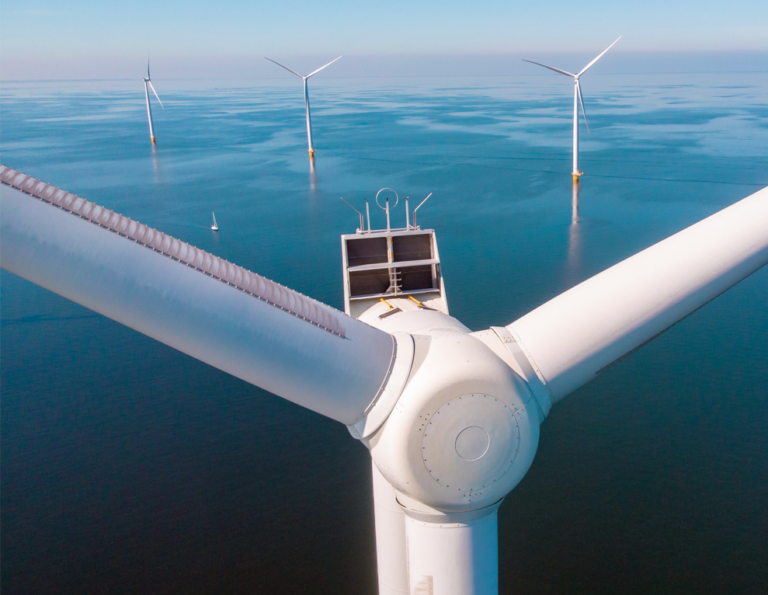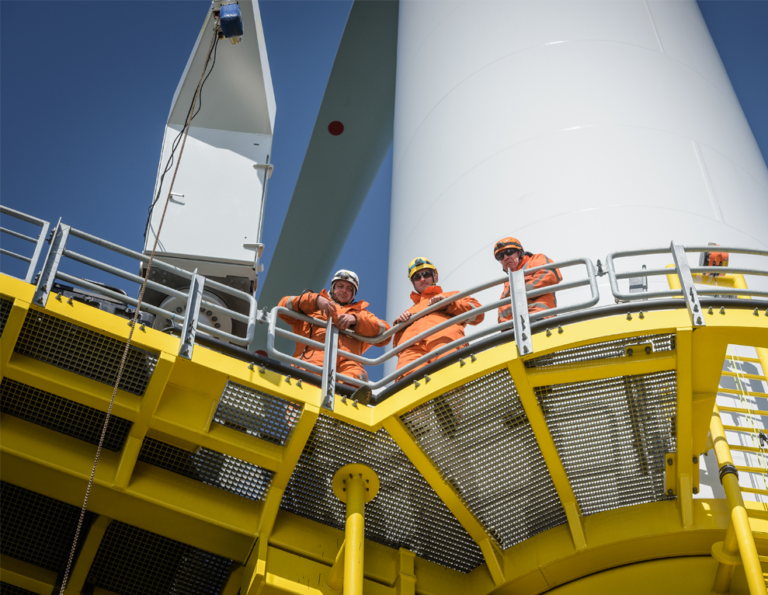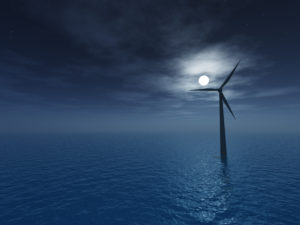Construction of offshore wind farms and species protection
The rotor in the wind and the whale in mind
It can get pretty loud for some sea dwellers when an offshore wind farm is built. Loud noises arise when the foundations of the wind turbines are driven into the seabed. Various methods have been developed to protect the harbor porpoises, harbor seals and seals that live in the North and Baltic Seas from the noise. Harbor porpoises in particular are considered endangered species; too loud underwater noises can temporarily impair their hearing and disrupt their communication. Long-lasting and very loud noise can also be life-threatening for the animals. To prevent this from happening, the offshore industry has worked hand in hand with the responsible authorities, such as the Federal Maritime and Hydrographic Agency (BSH) and the Federal Environment Ministry (BMU), to ensure that this does not happen initially developed extensive protective measures together as part of research projects. But how exactly does the erection of wind turbines at sea work and how are marine mammals protected from the noise produced?
Luring away - to quieter places!
During the construction of offshore wind farms, defined noise limits must not be exceeded. The ramming of the steel pipes of a wind turbine into the seabed at a distance of 750 meters must not be louder than 160 decibels on average and up to a maximum of 190 decibels as the peak value. The BSH has stipulated this since 2008. For the duration of the entire construction work, the underwater noise is monitored by several hydrophones (special measuring devices equipped with software) and underwater sound stations. The noise data then flows to the BSH and has recently been published on the agency's own platform MarineEARS collected over the long term. In the future, the database should record the entire underwater background noise in the North and Baltic Seas all year round.
Before the construction work starts, disturbing noises are sent out around the construction site so that the animals stay away - the so-called Dismay. In the past, pingers and "Seal Scarers" were used for this purpose; since 2017, the BSH has been using the instead Fauna Guard Systems before. These devices emit quieter noises in the higher frequency range than pingers and "seal scarers" and are therefore more pleasant for harbor porpoises and seals.
In pilot projects by the research company Bio Consult, the team even managed to track the activities of marine mammals around the construction site monitor in real time. After the deterrence, so-called CPODs ("cetacean-porpoise detectors") - buoys that record the echo of porpoises in the area of the ramming point - are used as standard. The buoys have to be recovered for evaluation, which is why the data cannot be transmitted immediately. The Bio Consult team tested so-called WDS buoys (“wireless detection system”). They transmit their data by radio and enable real-time monitoring. As soon as a porpoise was recognized near the pile-up point, additional scare-off noises could be sent out immediately.
Noise protection measures - surround the noise ...
There are various technical processes and individual measures to contain the underwater noise that occurs when a wind turbine is set up. If you combine certain measures with each other, more than 20 decibels can sometimes be swallowed per pile driving. However, there is no such thing as a “one-size-fits-all” solution. The measures that can be used depend heavily on local conditions such as the nature of the seabed, the current and water depth. But what exactly do the different approaches look like and where are they used?
Creating small air bubbles under water that swallow some of the sound - this is currently the most common noise protection measure in Germany. They are available in single and double versions ("single big bubble curtain" - BBC; "double big bubble curtain" - DBBC). In rare cases, a triple bubble veil is also used. One or two hose or pipe systems, which emit rising bubbles, are laid on the seabed at a relatively large distance around the ramming point. In the smaller variant - the so-called small bubble veil - there are several rings around the pile and create the air bubbles. If you want to let the air bubbles rise independently of underwater currents, a guided bubble veil can be used. The air bubbles rise along a membrane or wall.
According to previous experience, a double bubble curtain (DBBC) can save 15 to 16 decibels at water depths of around 40 meters. How much noise can be contained is also determined by factors such as the size of the nozzles in the hoses, the amount of air used and the distance and length of the nozzle hoses.
There is also one here Explanatory video about the bale veil of the company Hydrotechnik Lübeck.
The Hydro silencer is used in Germany in combination with a single or double large bubble curtain. The HSD system consists of a network with foam elements in various sizes. Each of these HSD elements is tuned to different frequencies. This enables both high and low noises to be intercepted at different sea depths. In contrast to bubble curtains, the shape, size, number and arrangement of the artificial air bubbles can be precisely adjusted with the hydraulic noise suppressor.
So far, this noise protection system has been used as standard for monopile pile driving in the North and Baltic Seas. This can save up to ten decibels per pile driving. Vattenfall used the silencer for the first time during the construction of the Sandbank offshore wind farm in 2015 successfully tested and used.
If larger pile sizes of up to eight meters in diameter have to be driven into the seabed, the hydraulic noise suppressor is usually combined with a double bubble curtain. However, the noise savings values of the individual measures cannot simply be added up. Instead, a little more sound can simply be absorbed in total than the individual measures could alone.
In the North Sea, thanks to a combination of measures, the construction work was already up to 18 to 19 decibels quieter. In the German Baltic Sea, the noise reductions varied more, which may be due to other seabed properties Experts from the Institute for Technical and Applied Physics. Since the Baltic Sea is calmer and has fewer currents than the North Sea, they assume that even more noise can be reduced there.
Ducts are particularly suitable for erecting monopiles. With sophisticated concepts, they can also be used with other types of foundations. The pipes are designed either double-walled or as a single-walled variant with insulation made of air, foam or a bubble curtain that surrounds the entire length of the pile. The use can be handled in different ways:
A crane pulls the pipe over the pile that has already been lowered to the seabed; the pile is pushed into the duct on the erecting ship, then set down on the seabed and lifted back after pile driving; or the duct is lowered mechanically to the seabed by the installation ship and only then is the pile lowered. How practicable this process is was demonstrated during the construction of the offshore wind farm “Riffgat”: 30 monopile foundations were driven into the sea floor together with a 30 meter long and 10 meter wide double-walled steel pipe with an internal bubble curtain. The use is logistically somewhat more complex, however, since a corresponding crane and storage room for the cladding tube must be available.
Noise reduction measures - less ado about a lot
In addition to methods of preventing the underwater noise from spreading, there are also ways of not generating as much noise in the first place during construction. So-called noise reduction systems ensure this. What sounds bulky in technical jargon is in principle simple. We present some approaches.
With this measure, the sound is not attenuated, but the source level is reduced. This is possible by, to put it bluntly, ramming less hard, which in turn can be compensated for with a larger hammer. According to previous experience, two to three decibels can be saved for every halving of the pile driving force. Based on these findings, a so-called “sound-optimized” pile-driving process has been established in Germany in recent years. This is a possible large pile hammer of the latest generation with a ram thickness reduced by 50 to 60 percent. The process can be easily combined with a second soundproofing measure, such as a bubble curtain.
Larger wind turbines have more capacity, ergo the desired megawatt capacity can be achieved faster with the construction of larger systems and less pile-driving work has to be carried out, which causes less overall noise.
A combination of shaking and ramming can shorten the duration of the noisy ramming. When shaking, leave rotating weights in the Vibratory hammer vibrate the pole, driving it into the seabed. The vibratory hammer causes the pile to vibrate vertically at a frequency of around 20 hearts. This "vibration noise" in the lower frequency range no longer propagates in the shallow water of the North and Baltic Seas. However, higher-frequency vibrations also occur, which accompany the sound level in the water when the vibratory hammer is in use. This method still requires some research to better understand the effects on the soil and the stability of the foundations.
But it also works without ramming. In addition to the classic steel pipes (monopiles), there is also the "suction bucket jacket" method with suction bucket foundations. The foundations, which look like upturned buckets, suck themselves into the ground almost noiselessly by means of negative pressure. These foundations have been used in the oil and gas industry for many years. Orsted was the first company to adopt the technology for the wind turbines, and in 2014 in the wind farm "Borkum Riffgrund 1" Tried for the first time. For "Borkum Riffgrund 2" 20 of these foundations were used. With the “Aberdeen Bay Offshore Project” off Scotland, Vattenfall has built an entire park on these suction bucket foundations.
On the trail of whales - what does the studies say?
In 2019 the Federal Association of Offshore Wind Farm Operators announced commissioned a study, which examined the effects of pile driving in the construction of offshore wind farms and the resulting sound waves on harbor porpoises in the German North Sea. In the so-called overall study of sound effects 2, the construction work of eleven wind farms in the German North Sea was accompanied. The aim was to find out whether the sound waves would contribute to driving harbor porpoises out of local waters in the long term. The study was carried out by the company BioConsult SH, IBL Umweltplanung and the Institute for Applied Ecosystem Research (IFaOe).
For this purpose, hydro sound data from forest detectors (C-PODs) as well as data from porpoise counts from the aircraft in the German Bight from 2014 to 2016 as well as the database of a Previous study from 2009 to 2013 evaluated. The researchers found that the activity of the porpoises remained constant. A long-term displacement and shrinking of the population could not be determined on the basis of these data. The results, however, indicate constant harbor porpoises in the German North Sea.








